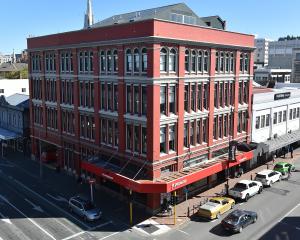Slideshow: Mosgiel's many charms="http:>
On a sunny summer's day, Mosgiel presents an air of small-town charm to the world.
Pedestrians stroll the compact main street, traffic is light, people sip coffee and cold drinks at outdoor tables and townsfolk pass the time of day.
Just around the corner - for nothing is too far apart in Mosgiel - the town's latest attraction is providing plenty of entertainment for the next generation.
The swept-up, all-age playground, started two years ago and now almost complete, makes a solid statement about the confidence residents have in the town's future.
A fenced junior playground area allows young children to play while safely contained.
Modern climbing and play equipment has been added for older children alongside the existing skateboard park. Pathways and chairs and tables have been added.
A large swing has been installed which can be used by both able-bodied people and those in wheelchairs.
The junior playground is about to be extended, and new public toilets will soon be installed. If money allows, a giant swing which would be the first of its type in New Zealand may be erected.
A small group of young parents have partnered with the Dunedin City Council to design and raise funds for the playground, which will have cost $775,000 by the time it is finished.
Geoff Woodcock, chairman of the Mosgiel Community Facilities Trust, said he and other parents got involved after the council said it would invest $200,000 in Mosgiel playgrounds and parents realised that money would not go very far.
Grants, donations and much local fundraising resulted in the trust raising an additional $400,000.
Parents were looking for an improved playground for their own children, as well as a "destination playground" which would attract families from Dunedin.
The facility was already drawing people to the town, Mr Woodcock said.
"Heaps of school trips stop here on their way to somewhere else."
Like many others, new Mosgiel residents Geoff and Melanie Woodcock were drawn to Mosgiel four years ago because of its small-town feel.
They had two children then; now they have four - Jacob (almost 7), Keziah, Gabrielle and Tim (6 months).
The playground, and Mosgiel's other community facilities, were fantastic for the children, Mr Woodcock said.
Most people were confident the current economic difficulties would not impact too much on Mosgiel, he said.
"Development might slow down a bit, but that is not a bad thing. I don't think people want Mosgiel to be any bigger than a nice little town."
Ironically, after all their hard work for Mosgiel, Mr Woodcock and his family are moving 10km along the road to Outram.
Mr Woodcock said he and his wife felt a smaller school was important for their children, and they hoped Outram would have more community cohesion than Mosgiel.
Julie Farr and Rachael Brinsdon are co-presidents of the Mosgiel Playcentre, one of several preschools that have benefited from young families choosing to settle in the town.
The playcentre roll had grown significantly in the past 10 years, with new families having to join a waiting list. Growth had now plateaued, they said, although there was still a small waiting list.
"We've probably got a smaller number of families now than we had a few years ago, but the families we have are more committed. More children come more often during the week and the playcentre is busier," Mrs Farr said.
Both were enthusiastic about the playground, and about Mosgiel's facilities for young families.
"The playground is tremendous - awesome. And the grass area is a good, safe place for the children to learn to ride their bikes," Mrs Farr said.
The parents are among many young families who have settled in Mosgiel over the past decade - a period which was good to Mosgiel.
New residents were attracted at both ends of the age range as subdivisions full of new family homes steadily sprang up on the town's fringes and two of the three retirement villages expanded.
While the population of most other parts of Dunedin city remained static or reduced slightly over that period, Mosgiel experienced growth of 7.4%.
Shops, trades companies and service industries grew to meet increased demand.
Fisher and Paykel expanded its factory and became the town's major employer, with an estimated half its peak workforce of around 700 coming from the Mosgiel-Taieri area.
A 37ha patch of rural land was rezoned industrial, with high hopes numerous companies would establish or relocate on the Taieri. Last year, 115ha of rural land around Mosgiel was rezoned residential.
While development of that land was always going to be a long-term prospect, the potential was there for Mosgiel's population to increase by several thousand. Then, virtually overnight, the picture changed.
Fisher and Paykel announced it would close its factory in March, relocating its research and development department to Dunedin and establishing a national call centre.
Other significant employers also announced job losses.
Sky-high petrol prices made the 15-minute commute to work or leisure activities in Dunedin less attractive.
The two main largest retirement villages, Chatsford and Brooklands, were finally full, with little room for significant expansion.
Mosgiel's future was suddenly looking less rosy.
But there is that word "resilience".
Mosgiel has taken body blows before and survived, Dunedin deputy mayor and councillor for the Mosgiel-Taieri ward Syd Brown says.
It survived the closure of the Fortex meat processing plant in 1994 and the Alliance yarn factory in 2000, and it would survive Fisher and Paykel's departure.
"Mosgiel is a very resilient town, and Mosgiel has a very resilient workforce."
Mosgiel's strengths were its stability, its employment opportunities in the town and in Dunedin, and its conservative approach, he said.
"Some of what is happening is because of world trends which we can't control, but Mosgiel is very traditional and very conservative and that is going to stand us in good stead."
While there was "no doubt" there would not be a boom in residential development as there had been through most of the 2000s, managed growth was not a bad thing, he said.
Cr Brown said he sensed a resurgence in the logging and timber processing industries, and continued employment opportunities in elderly care and rural servicing.
The most promising opportunity was that Mosgiel would likely become a base for the staff and services required for two large wind farms planned for the hills northwest of Outram.
Why live in Mosgiel?
-Small town, community feel, and friendly people.
-Great weather - sheltered from the easterly winds which plague coastal Dunedin and officially 1.4degC warmer on average than the city on a summer's day.
-Plenty of services - two supermarkets; wide range of trades, shops, banks, cafes and restaurants; free parking; variety of take-away outlets catering to all tastes (and no McDonald's).
-Ample education including a secondary school, four primary schools and several preschools.
-Community facilities including library, swimming pool, velodrome, toy library, parks, playgrounds, skateboard park, pleasant walkway along the banks of the Silver Stream, dog exercise park.
-A 15-minute drive from the hustle and bustle of central Dunedin.
A landmark
The twin humps of Saddle Hill which separate the Taieri Plain from the southern coast, form a distinctive landmark which can see seen for many kilometres.
Captain James Cook noted the feature in his journal entry for February 25, 1770: "There is a remarkable Saddle hill lying near the shore, three or four leagues southwest of the cape. . ."
The cape was Cape Saunders, the eastern-most point of Otago Peninsula.
Maori legend says Saddle Hill is the final resting place of a taniwha (water monster) who lost his mate somewhere near Dunedin and roamed the countryside looking for her, creating the Waka-Ehu (Silver Stream), a large swampy hollow on the plain and the Taieri River on the way.
He lies looking towards Lake Waihola.
The twins peaks are his head and body, while the Chain Hills, which run between the plain and Fairfield, are his tail.
Source: Pulse of the Plain: A History of Mosgiel, by Ron Kirk
Population growth
Population of Mosgiel, including Wyllies Crossing, East Taieri and Wingatui
1996: 11,130
2001: 11,247
2006: 11,964
Difference: +834 (7.4%)
Source: Statistics NZ census data
A brief history
-Pre 1830s: Most of the Taieri Plain swampy or covered in bush, with waterways easily navigated by local Maori.
Main settlement Tai-ari kaika, near Henley.
-1830s: Taieri Plain recognised as prime farmland by early European settlers. Large tract of native bush identified as ready supply of timber for buildings.
-1840s: Tracks created across Taieri Plain to Central Otago, and along southern edge to Allanton and points south. Most of plain divided into 52 acre blocks for sale to new immigrants.
Roads created between blocks, including Gladstone Rd, Riccarton Rd, Bush Rd and Factory Rd, which still exist.
-1855: Arthur Burns, son of Thomas Burns, the first minister and co-leader of the Scottish Free Church settlement of Dunedin, breaks in Taieri land and calls farm Mossgiel. Single 's' spelling of Mosgiel soon adopted.
-1850-60s: Bush Rd/Factory Rd/Gordon Rd intersection becomes commercial hub of new town. Other industries including sawmills, flour mill, brickworks, condensed milk factory and butter factory spring up.
-1871: Arthur Burns establishes Mosgiel Woollen Mill in partnership with John Smaill. Machinery purchased and experienced workers hired in Scotland.
Mr Smaill, a factory manager, 299 boxes of machinery and 24 factory hands arrive at Port Chalmers on May 28, 1871, aboard the Helenslee. First cloth produced five months later.
-1875: Dunedin-Clutha railway line and Mosgiel Railway Station open.
-1877: Taieri County Council established.
-1882: Mosgiel declared "town district" and town board elected.
-1950s: Developers turn fields into new housing subdivisions, bringing an influx of young families to the town. Population almost trebles from 2349 in 1945 to 6456 in 1961.
-1970s: Shacklock (now Fisher and Paykel) builds manufacturing plant on Dukes Rd, North Taieri. East Taieri becomes part of the Mosgiel borough.
-Late 1980s: Fortex builds meat processing plant at North Taieri which at its peak employs more than 900.
-1989: Mosgiel borough dissolved and town amalgamated into new Dunedin City Council. Mosgiel Borough Council replaced with community board.
-1976: Mosgiel's first retirement village built, the Salvation Army's 60-unit Elmwood Cottages complex. Mosgiel now has five rest-homes, two geriatric hospitals, dementia unit and three retirement villages with about 800 residents and almost 300 staff.
-Early 1990s: Mosgiel Hospital closes and main wing converted into geriatric hospital.
-1994: Fortex plant closes. Some buildings taken over by PPCS (now Silver Fern Farms).
-2000: Mosgiel Woollen Mill (now called the Alliance yarn factory) closes with loss of 141 jobs.
-2003: Mosgiel's main street undergoes $450,000 upgrade, including "Taieri River" patterned footpaths. Ministry of Education closes eight Taieri schools, including three in Mosgiel. 2004: A further 37ha of rural land on Dukes Rd rezoned industrial.
-2008: Environment Court finally approves residential rezoning for 115ha of rural land on the outskirts of Mosgiel. Fully developed, land could support 1400-1640 homes.
Fisher and Paykel announces dishwasher factory will close in March this year with loss of more than 400 jobs. Mosgiel firms NZ Wood Mouldings, Silver Fern Farms and O'Briens Laminates also shed staff.
Sources: Pulse of the Plain: A History of Mosgiel by Ron Kirk; ODT files.












